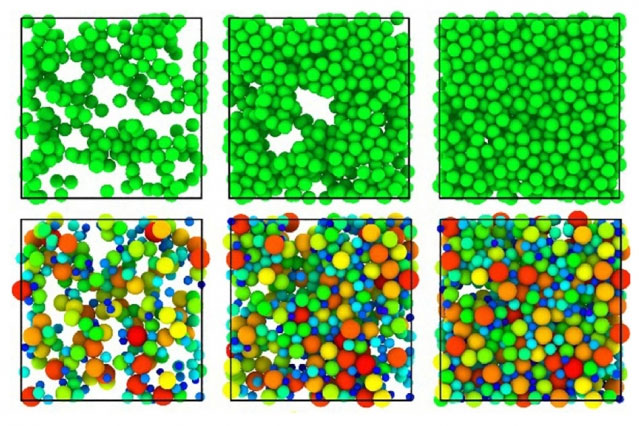
Cement materials, including cement paste, mortar, and concrete, are the most widely manufactured materials in the world. Their carbon footprint is similarly hefty: The processes involved in making cement contribute almost six percent of global carbon emissions.
The demand for these materials is unlikely to decline any time soon. In the United States, the majority of concrete bridges, buildings, and pavement-lined streets, erected in the 1960s and 1970s, were designed in an era with fewer environmental stresses to infrastructure and built to last 50 years at most.
Now, MIT researchers have discovered the beginnings of a new approach to producing concrete that is inspired by the hierarchical arrangements of simple building blocks in natural materials. The findings could lead to new ways to make concrete stronger and to use more sustainable, local materials as additives, to offset concrete’s greenhouse gas emissions.
In the new study, Oral Buyukozturk, a professor of civil and environmental engineering, and his colleagues analyzed a key property in concrete, at the level of individual atoms, that contributes to its overall strength and durability. The group developed a computer model to simulate the behavior of individual atoms which arrange to form molecular building blocks within a hardening material.
These simulations revealed that an interface within the molecular structure exhibited a ‘frictional’ resistance under sliding deformation. The team then developed a cohesive-frictional force field, or model, that incorporates these atom-to-atom interactions within larger-scale particles, each containing thousands of atoms. The researchers say that accurately describing the forces within these assemblies is critical to understanding the way strength develops in concrete materials.
The team is now examining ways in which the cohesive and frictional forces of groups of atoms, or colloids in cement, are improved by mixing in certain additives such as volcanic ash, refinery slag, and other materials. The team’s computer model may help designers choose local additives based on the molecular interactions of the resulting mixtures. Through careful design at the microscopic level, he says, designers and engineers can ultimately build stronger, more environmentally sustainable structures.
“The conditions of the world are changing,” Buyukozturk said. “There are increased environmental demands, including from earthquakes and floods, and stresses on infrastructure. We need to come up with materials that are sustainable, with much longer design life and better durability. That is a big challenge.”
Buyukozturk and his colleagues, graduate student Steven Palkovic and Sidney Yip, professor emeritus in MIT’s Department of Nuclear Engineering, have published their results in the Journal of the Mechanics and Physics of Solids.

Strength from friction
Buyukozturk’s vision for revamped, locally sourced concrete is inspired, in part, by Roman construction. During the empire’s peak, the Romans erected temples, bath buildings, and amphiteaters in Pompeii, Ostia, and through Spain and the Middle East, including towns in Turkey, Libya, and Morocco. In each far-flung location, archaeologists have found that the Romans constructed their buildings from local materials — a technique that has helped preserve these structures for more than 2,000 years.
“They probably did this through intuition,” Buyukozturk said. “Ours is an effort to hopefully implement that kind of philosophy of using materials that are locally available, by understanding the underlying scientific principles within those materials.”
In their new paper, the scientists describe a computer model that is part of a computational framework that they have developed to analyze how the atomic structure of concrete affects engineering properties. These models simulate the sliding and movement of clusters of particles at molecular scales within concrete.
The researchers used their atomistic model to simulate mixtures containing Portland cement, the most common type of cement used in the world. Specifically, they simulated the mechanical response of the gel-like substance called Calcium-Silicate-Hydrate (C-S-H), the main phase that forms when water reacts with Portland cement. The group modeled the movements of thousands of atoms in a C-S-H molecular building block, noting the influence of cohesive forces that cause particles to stick together, and the presence of a shear resistance as clusters of atoms slide past each other along a water-filled interface.
They then simulated how these molecular-scale properties control larger particles containing thousands of atoms, or colloids, at what they call the ‘mesoscale’. They discovered that the degree to which frictional properties resist the movement and separation of colloids at the mesoscale was the strongest factor in determining the strength of concrete at the centimeter scale.
Designers often use the properties of cement at the centimeter scale to predict the strength of a final, much larger-scale structure. The researchers thus implemented the results of their atoms-to-colloids simulations within computer models of the hardened microstructure, to allow for comparison with actual, centimeter-sized laboratory experiments. Buyukozturk found the team’s predictions matched with experimental outcomes better than predictions made with simulations that neglect frictional interactions.
“The material science of cement strength is still in its infancy regarding molecular-level descriptions and an ability to perform quantitative predictions,” Yip said. “The issue of frictional force, addressed in our work, pertains to the mechanical behavior of cement that varies over time. This rate sensitivity is an aspect of the scientific challenges at the mesoscale, which is the research frontier where microscale concepts and models developed in several physical science disciplines are linked to macroscale properties for technological applications.”
Buyukozturk added, “We are confident that our new framework is opening a new era in concrete science.”
Additives in the mix
The group is now working on integrating various additives into their model, to investigate the effect of such materials on the atom-to-atom behavior of cement, and the resulting strength of the final, solidified concrete. From preliminary studies, they have observed that there is a chemical dependence of the friction value, or degree to which colloids resist sliding against each other. Future work will investigate how additives influence the chemical composition of these colloidal phases. This information could be used as part of a database to design and optimize new concrete materials with improved strength and deformation behavior.
“We know relatively little of what happens when additives are used in concrete,” Palkovic said. “We would not expect volcanic ash from Saudi Arabia to give the same performance as volcanic ash from Hawaii. So we need this greater understanding of the material, that starts at the atomistic scale and accounts for the chemistry of the material. That can give us greater control and understanding of how we can use additives to create a better material.”
This research was supported, in part, by the Kuwait Foundation for the Advancement of Sciences, as part of the MIT-Kuwait signature project on sustainability of Kuwait’s built environment.

Comments are closed, but trackbacks and pingbacks are open.